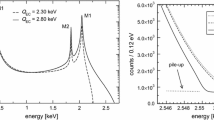Abstract.
In 1930 Wolfgang Pauli suggested that a new particle might be required to make sense of the radioactive-disintegration mode known as beta decay. This conjecture initially seemed impossible to verify since the new particle, which became known as the neutrino, was uncharged, had zero or small mass, and interacted only insignificantly with other matter. In 1951 Frederick Reines and Clyde L. Cowan, Jr., of the Los Alamos Scientific Laboratory undertook the difficult task of detecting the free neutrino by observing its inverse beta-decay interaction with matter. They succeeded in 1956. The neutrino was accepted rapidly as a fundamental particle despite discrepancies in reported details of the experiments and despite the absence of independent verification of the result. This paper describes the experiments, examines the nature of the discrepancies, and discusses the circumstances of the acceptance of the neutrino's detection by the physics community.
Similar content being viewed by others
Author information
Authors and Affiliations
Rights and permissions
About this article
Cite this article
Arns, R. Detecting the Neutrino. Phys. perspect. 3, 314–334 (2001). https://doi.org/10.1007/PL00000535
Issue Date:
DOI: https://doi.org/10.1007/PL00000535




